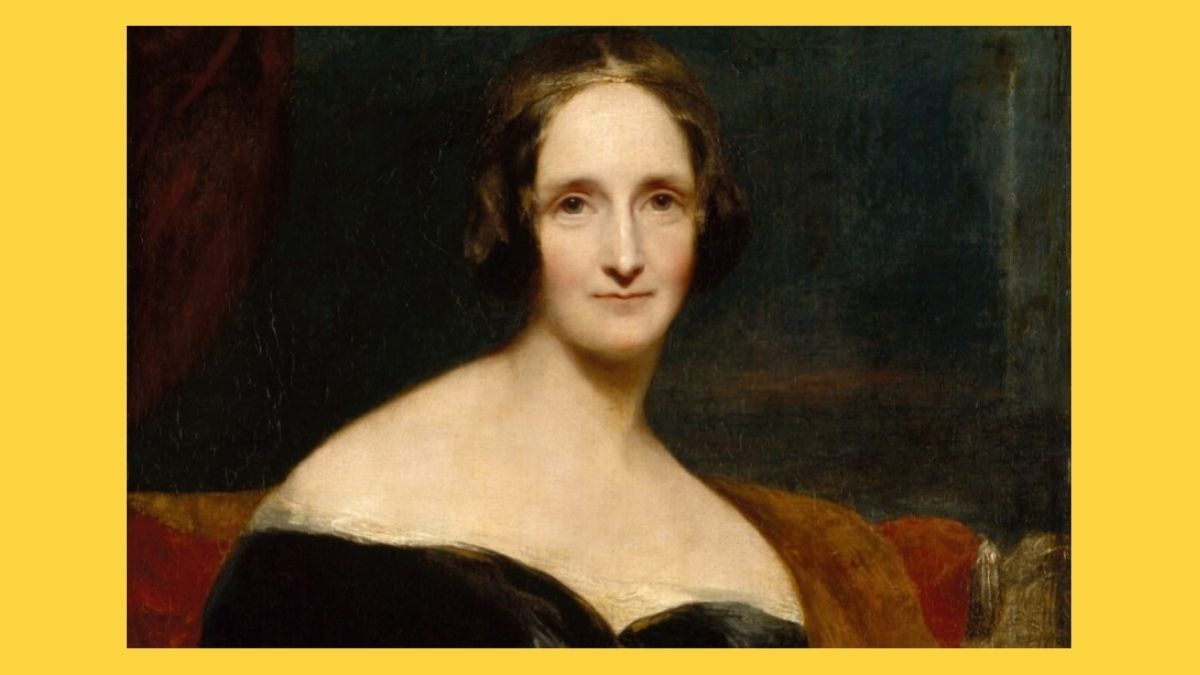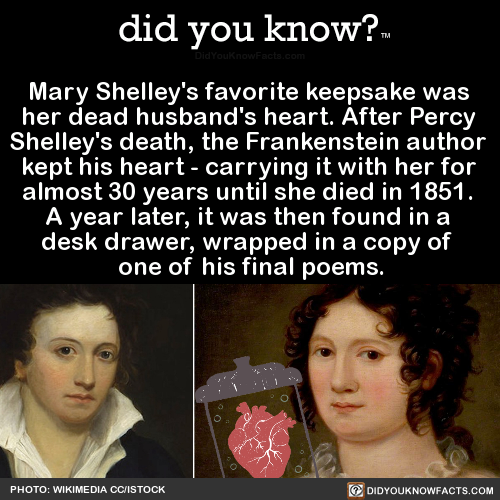A popular macabre story that is frequently shared around the Halloween holiday involves Mary Shelley, the author of gothic novels such as "Frankenstein," her late husband Percy Bysshe Shelley, a romantic poet, and the burned remains of a human heart:
This meme recounts a popular legend about the gothic author and her late husband. Some of the details in this story are disputed (some maintain that it was Percy's Kidney, not his heart, that Shelley kept), and as the most popular accounts of Percy's death and burial originated with a group of gothic fiction writers with a flare for poetic language, some portions of this tale may have been exaggerated.
By and large, however, it's accurate to say that Mary Shelley kept the remains of one of her husband's internal organs. This wasn't entirely unusual at the time. The BBC reports that it was relatively common in Victorian England to take photos with dead relatives that were propped up in poses, or to make jewelry containing the hair of the deceased.
This tale dates back to 1822 when Percy drowned while sailing his boat, the Don Juan, through a summer storm across the Gulf of Spezia in Italy. When his remains were found a few days later by friend and novelist Edward John Trelawny, a fire was built on the beach and he was cremated. To Trelawney's surprise, however, Percy's heart would not succumb to the flames. The hardened remains of Percy's heart was plucked from the ashes and, after an argument over who would keep the remains, were eventually given over to Percy's wife, Mary Shelley.
While Percy was a well-known poet, his sudden death at the young age of 29 lifted him to a mythical status. This occurred, in part, because the various accounts of his death and burial were written by fellow poets and novelists. The Guardian wrote in 2004:
"... This sudden tragedy set a kind of sacred (or profane) seal upon his reputation as a youthful, sacrificial genius. But far more comprehensively than theirs, Shelley's death was used to define an entire life, to frame a complete biography. It produced not hagiography, but thanatography.
Through an astonishing array of pictures, poems, inscriptions, memoirs and Victorian monuments, this death spun a particular image of Shelley's character more effectively than any modern PR campaign. It projected a writer who was unearthly, impractical and doomed. In Matthew Arnold's notorious summation, Shelley was "a beautiful and ineffectual angel, beating in the void his luminous wings in vain". Shelley could always fly, but he could never swim.
[...]
The incorrigible myth-making Edward John Trelawny ... obsessively re-wrote his account [of Percy's death and burial] nearly a dozen times over the next 50 years, accumulating more and more baroque details, like some sinister biographical coral-reef.
Trelawny wrote several accounts of Shelly's burial. In Rosalie Glynn Grylls' biography of Trelawny, she credits the author with putting "poetry into what began as a practical proceeding and what he wrote of it made it romantic." Here's how Grylls' describes Trelawny's telling of the scene:
Trelawny's accounts bring out what was macabre as well as what was picturesque: The noise of the mattock as it first struck Shelley's skull when the men were digging to find the body in the sand, and the seething and bubbling of the brains as if they were boiling in a cauldron while the flames leapt as high as the tops of the pines. Though the iron of the furnace was white-hot, the heart was not consumed. Trelawny plunged in his hand and snatched it out.
Different theories have been offered as to why Percy's heart wasn't consumed by the flames. Trelawny argued that "in all cases of death from suffocation the heart is gorged with blood ; consequently it is the more difficult to consume, especially in the open air." In 1885, the London Athenoeum questioned whether Percy's heart was truly removed from the flames and suggested that it was a liver saturated with sea water that was pulled from the flames. Others have argued that Percey's heart didn't burn because it had become calcified due to an earlier bout with tuberculosis.
While the exact details of Percy's disappearance, death, and burial may be a little hazy, it appears that part of his remains truly did end up in Mary Shelly's possession. In Emily Sunstein's 1989 biography of Shelley, she notes that a year after Shelley passed in 1851, her son, Percy Florence Shelley, found the remnants of his father's heart in a box that Shelly had kept on her desk. The heart was wrapped in a piece of silk that also held a bit of his ashes and a torn out passage from Percy's poem Adonais.
Percy [Florence Shelley] could not bear to be in the house where his mother died or to let anyone touch her things. He and Jane moved to Boscombe Manor and sold Chester Square. Not until the first anniversary of Mary Shelley's death did they open the box-desk she had kept near her bed and found relics she had not shown even them: her copy of Shelley's Adonais with one torn-out leaf folded around a piece of silk that held a bit of his ashes and the remnant of his heart, a box containing a workbook they had shared and locks of hair of her dead William and Clara.

